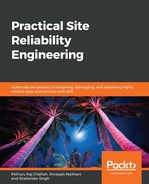Book Description
Create, deploy, and manage applications at scale using SRE principles
Key Features
- Build and run highly available, scalable, and secure software
- Explore abstract SRE in a simplified and streamlined way
- Enhance the reliability of cloud environments through SRE enhancements
Book Description
Site reliability engineering (SRE) is being touted as the most competent paradigm in establishing and ensuring next-generation high-quality software solutions.
This book starts by introducing you to the SRE paradigm and covers the need for highly reliable IT platforms and infrastructures. As you make your way through the next set of chapters, you will learn to develop microservices using Spring Boot and make use of RESTful frameworks. You will also learn about GitHub for deployment, containerization, and Docker containers. Practical Site Reliability Engineering teaches you to set up and sustain containerized cloud environments, and also covers architectural and design patterns and reliability implementation techniques such as reactive programming, and languages such as Ballerina and Rust. In the concluding chapters, you will get well-versed with service mesh solutions such as Istio and Linkerd, and understand service resilience test practices, API gateways, and edge/fog computing.
By the end of this book, you will have gained experience on working with SRE concepts and be able to deliver highly reliable apps and services.
What you will learn
- Understand how to achieve your SRE goals
- Grasp Docker-enabled containerization concepts
- Leverage enterprise DevOps capabilities and Microservices architecture (MSA)
- Get to grips with the service mesh concept and frameworks such as Istio and Linkerd
- Discover best practices for performance and resiliency
- Follow software reliability prediction approaches and enable patterns
- Understand Kubernetes for container and cloud orchestration
- Explore the end-to-end software engineering process for the containerized world
Who this book is for
Practical Site Reliability Engineering helps software developers, IT professionals, DevOps engineers, performance specialists, and system engineers understand how the emerging domain of SRE comes handy in automating and accelerating the process of designing, developing, debugging, and deploying highly reliable applications and services.
